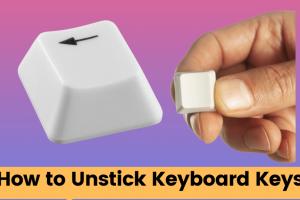5 Proven Methods to Unstick a Keyboard Key on Your Computer or Laptop

-
Quick Links:
- 1. Clean Your Keyboard Thoroughly
- 2. Use Compressed Air for Debris Removal
- 3. Check for Key Misalignment
- 4. Remove and Reattach the Keycap
- 5. Seek Professional Help if Necessary
- FAQs
1. Clean Your Keyboard Thoroughly
One of the most common reasons for sticky keys is accumulated dirt, dust, and grime. Over time, particles can build up beneath the keys, preventing them from functioning properly. Here’s how to clean your keyboard thoroughly:
Step-by-Step Cleaning Process
- Gather Your Supplies: You’ll need a microfiber cloth, isopropyl alcohol, and cotton swabs.
- Shut Down Your Device: Ensure that your computer or laptop is turned off and unplugged.
- Wipe the Surface: Use the microfiber cloth dampened with isopropyl alcohol to wipe the keyboard surface.
- Clean Between the Keys: Use a cotton swab dipped in alcohol to clean the spaces between the keys.
- Let it Dry: Allow the keyboard to completely dry before turning your device back on.
According to a study by the American Cleaning Institute, regular keyboard cleaning can reduce allergens and improve overall health.
2. Use Compressed Air for Debris Removal
Sometimes, all it takes to unstick a key is to remove the debris lodged under the keycap. Compressed air is an effective solution for this issue.
How to Use Compressed Air
- Purchase Compressed Air: You can find compressed air cans at most electronics or office supply stores.
- Angle the Nozzle: Hold the can at an angle, ensuring it's not directly upside down.
- Spray Between Keys: Use short bursts of air to dislodge any particles stuck underneath the keys.
- Repeat as Necessary: You may need to repeat this process for multiple keys.
Using compressed air is an effective method recommended by many tech experts, including those at Laptop Mag.
3. Check for Key Misalignment
If cleaning doesn’t resolve the issue, the key may be misaligned. Misalignment can occur due to improper pressing or physical damage. Here’s how to check and fix it:
Steps to Check Key Alignment
- Inspect the Key: Look closely at the key and see if it appears crooked or uneven compared to neighboring keys.
- Press Down Gently: Try pressing down gently on the key to see if it snaps back into place.
- Adjust if Necessary: If the key is misaligned, gently lift it off and re-center it before pressing it back down.
Misalignment issues can often be resolved with minimal effort, saving you from costly repairs. For more in-depth guidance, check out resources from Digital Trends.
4. Remove and Reattach the Keycap
If the key remains stuck after the previous methods, removing the keycap may be necessary. Here’s how to do it safely:
Steps to Remove Keycaps
- Gather Tools: You may need a flathead screwdriver or a keycap puller.
- Carefully Pry Off the Keycap: Insert the tool gently under the corner of the key and lift it off.
- Clean Beneath the Key: Use a cloth or cotton swab to clean the area beneath the keycap.
- Reattach the Keycap: Align it properly and press down firmly until you hear a click.
Removing and reattaching keycaps can be risky; therefore, consult guides on sites like TechRadar for detailed instructions.
5. Seek Professional Help if Necessary
If none of the above methods work, it may be time to seek professional help. This is especially true for laptops with integrated keyboards or for mechanical keyboards with complex layouts.
When to Seek Help
- If multiple keys are stuck and cleaning doesn't help.
- If there’s visible damage or if the keycap doesn't reattach properly.
- If you are uncomfortable performing the previous steps.
Many computer repair shops offer diagnostic services. According to a report by iFixit, professional technicians can often identify issues that are not visible to the untrained eye.
FAQs
1. Can I use water to clean my keyboard?
No, it’s best to avoid water as it can damage the electronics. Use isopropyl alcohol instead.
2. How often should I clean my keyboard?
It’s advisable to clean your keyboard every month to prevent buildup.
3. What tools do I need to remove keycaps?
A flathead screwdriver or a keycap puller is typically sufficient.
4. Will cleaning void my warranty?
Cleaning your keyboard usually won't void a warranty, but check your specific warranty terms.
5. Can I replace individual keys?
Yes, individual keys can often be replaced if they are broken or not functioning.
6. What if the key is still stuck after cleaning?
If the key remains stuck, consider seeking professional help or replacing the keyboard.
7. Is it safe to use compressed air?
Yes, as long as you use it correctly and follow safety guidelines.
8. How do I know if my key is misaligned?
If the key looks uneven or wobbly compared to others, it may be misaligned.
9. Can keyboard problems be fixed at home?
Many keyboard issues can be addressed at home with the right techniques and tools.
10. Where can I find replacement keys?
Replacement keys can be found through online retailers or manufacturer websites.
Following the methods outlined in this article can help you effectively unstick a keyboard key, saving you time and frustration. Remember, regular maintenance is key to ensuring the longevity of your keyboard!
Random Reads
- Mastering excel dual y axes
- Mastering demon slayer quest runescape
- How to beat granny
- How to use seeds in minecraft pe
- How to use sd memory card
- How to design and build your own house
- How to desolder
- 4 simple ways to configure your home router
- How to hack android games game guardian
- How to reformat a laptop